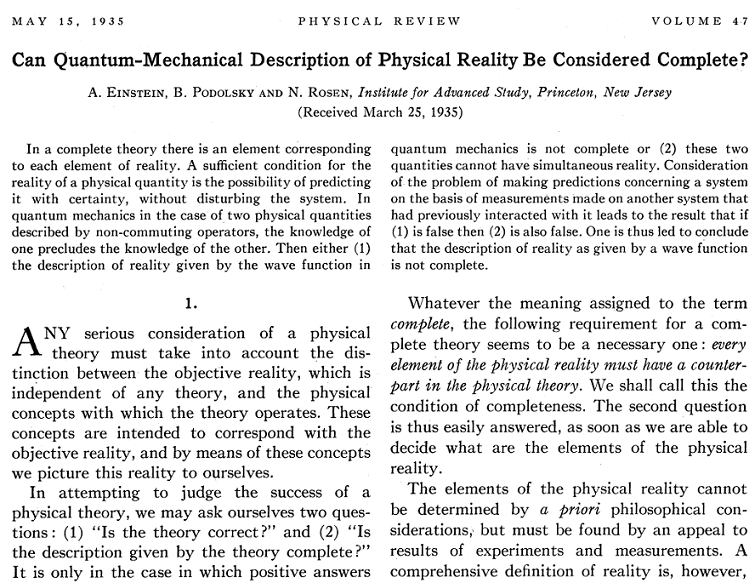|
home | what's new | other sites | contact | about |
||
|
Word Gems exploring self-realization, sacred personhood, and full humanity
Quantum Mechanics
return to "Quantum Mechanics" main-page
The final aspect of the Bohr-Einstein debate was conducted not at a Solvay congress but in the Physical Review journal. A 1935 paper by Einstein and two colleagues became known as "the EPR paraodx."
Wikipedia: The Einstein–Podolsky–Rosen paradox (EPR paradox) is a thought experiment proposed by physicists Albert Einstein, Boris Podolsky and Nathan Rosen (EPR), with which they argued that the description of physical reality provided by quantum mechanics was incomplete.[1] In a 1935 paper titled "Can Quantum-Mechanical Description of Physical Reality be Considered Complete?", they argued for the existence of "elements of reality" that were not part of quantum theory, and speculated that it should be possible to construct a theory containing them. Resolutions of the paradox have important implications for the interpretation of quantum mechanics. The thought experiment involves a pair of particles prepared in what later authors would refer to as an entangled state. Einstein, Podolsky, and Rosen pointed out that, in this state, if the position of the first particle were measured, the result of measuring the position of the second particle could be predicted. If instead the momentum of the first particle were measured, then the result of measuring the momentum of the second particle could be predicted. They argued that no action taken on the first particle could instantaneously affect the other, since this would involve information being transmitted faster than light, which is forbidden by the theory of relativity. They invoked a principle, later known as the "EPR criterion of reality", positing that, "If, without in any way disturbing a system, we can predict with certainty (i.e., with probability equal to unity) the value of a physical quantity, then there exists an element of reality corresponding to that quantity". From this, they inferred that the second particle must have a definite value of position and of momentum prior to either being measured. This contradicted the view associated with Niels Bohr and Werner Heisenberg, according to which a quantum particle does not have a definite value of a property like momentum until the measurement takes place.
The EPR paradox (or the Einstein-Podolsky-Rosen Paradox) is a thought experiment intended to demonstrate an inherent paradox in the early formulations of quantum theory. It is among the best-known examples of quantum entanglement. The paradox involves two particles that are entangled with each other according to quantum mechanics. Under the Copenhagen interpretation of quantum mechanics, each particle is individually in an uncertain state until it is measured, at which point the state of that particle becomes certain. At that exact same moment, the other particle's state also becomes certain.
|
||
|
|
